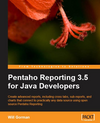This week, the Pentaho team released our first release candidate of our 2.0 Business Intelligence Server. The entire Orlando team worked many months on the brand new features incorporated into this release. I’m going to highlight some of the most exciting features that we’re all proud of at Pentaho:
A New User Console
In this release, we built from the ground up an entirely new user interface designed to greatly enhance the user experience of our Business Intelligence Server. Taking advantage of Google’s Web Toolkit’s amazing technology, we were able to deliver a complete Web 2.0 dynamic experience to our business users. We’ve modernized the look and feel of our analysis views and adhoc reporting tool, along with greatly simplifying permissions management.
Data Source and User Management
For the first time, our Community Edition Business Intelligence Server also comes shipped with an Administration console, for management of Users and Relational Data Sources. In addition to our default support for direct JDBC and JNDI connections, we also have the ability to define a Pentaho Managed Data Source. This makes it easy for business users to add their own data sources, without having to know the ins and outs of the Java Enterprise Container hosting Pentaho’s BI Server.
Metadata Row Level Security
Another important enhancement to our product offering is the ability to manage row level security from within our Metadata Layer. In our first release of Pentaho Metadata, we implemented Model, View and Column Level Security. In this release we extend our Security functionality to also include Row Level Constraints. Check out the documentation!
There are countless other features that went into our Community Edition release. At the same time, we’re also releasing our Enterprise Edition software, which includes features such as enhanced ETL Administration, along with many additional BI Server Administration and Configuration capabilities. These are exciting times!
 Comments(0)
Comments(0)